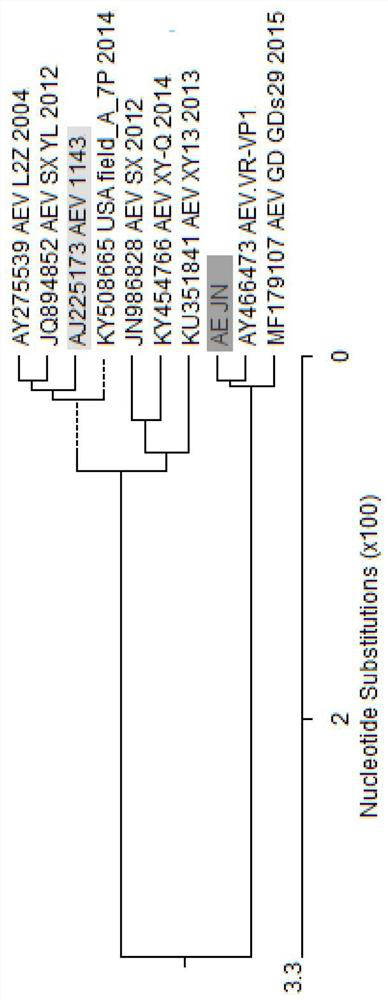A Strain of Avian Encephalomyelitis Virus and Its Application
A technology of avian encephalomyelitis, virus, applied in the field of animal virology
- Summary
- Abstract
- Description
- Claims
- Application Information
AI Technical Summary
Problems solved by technology
Method used
Image
Examples
Embodiment 1
[0024] A strain of avian encephalomyelitis virus, the isolation and acquisition process of the virus is as follows:
[0025] In December 2016, in a layer chicken farm of a local breed in Jinan City, a suspected AE infection occurred in the chicken farm. The cloacal cotton swabs of the layer chickens were taken aseptically treated and inoculated with the yolk sac of 6-day-old SPF chicken embryos, and the incubation continued for 12 days. The chickens were observed Embryopathies. The first-generation chicken embryos had no lesions, and the chicken embryo brains were aseptically harvested. After repeated freezing and thawing for 3 times, they were passed on SPF chicken embryos. After 12 days of inoculation, the SPF chicken embryos showed weakened activity, dysplasia, short stature, muscle atrophy, toe deformation and The characteristic lesions of AE such as betel nut liver were preliminarily identified as avian encephalomyelitis virus by animal regression test, and named it AEV J...
Embodiment 2
[0027] Relevant detection and analysis of embodiment 2 virus
[0028] 1. For the detection of virus content, use sterilized normal saline to dilute the virus species 10 times, and take 10 -5 、10 -6 、10 -7 、10 -8 4 dilutions, yolk sac route to inoculate 5-6 day-old SPF chicken embryos, inoculate 0.2ml per embryo. After inoculation, continue to incubate at 37°C, illuminate the eggs every 8 hours, take out the dead embryos in time, and discard the dead chicken embryos within 72 hours, depending on whether the dead chicken embryos after 72 hours or have the following symptoms: chicken embryo development retardation, short stature , brain edema, progressive muscle atrophy, toe deformation, and betel nut liver are AE lesions. The observation results of chicken embryo death and lesions are shown in Table 1. According to the number of chicken embryo lesions, EID is calculated according to the Reed-Muench method 50 , virus content≧10 per 0.2ml 6.75 EID 50 .
[0029] Table 1 EI...
Embodiment 3
[0049] The preparation of embodiment 3 inactivated vaccines
[0050] Use the E3 generation of AEV JN as the seed virus, dilute it with sterilized normal saline or PBS at 1:100, inoculate the yolk sac with 6-day-old SPF chicken embryos, hatch to 16-day-old, place at 2-4°C overnight, and take the ones with obvious lesions Chicken embryos, take the homogenate of the embryo body (discard the eyes and limb bones), make a suspension with PBS or the same batch of allantoic fluid at a ratio of 1:3, freeze and thaw 3-5 times, or use ultrasonic treatment, and place in sterilized In a sterile container, filter it with sterilized four-layer gauze into a sterile container, add 10% formalin to make the final concentration of formaldehyde 0.2%, and inactivate it in a constant temperature shaking incubator at 37°C for 24 hours. After the inactivation test is qualified, it is emulsified according to the ratio of oil to water 2:1 to prepare an oil emulsion inactivated vaccine;
[0051] The vac...
PUM
 Login to View More
Login to View More Abstract
Description
Claims
Application Information
 Login to View More
Login to View More - R&D
- Intellectual Property
- Life Sciences
- Materials
- Tech Scout
- Unparalleled Data Quality
- Higher Quality Content
- 60% Fewer Hallucinations
Browse by: Latest US Patents, China's latest patents, Technical Efficacy Thesaurus, Application Domain, Technology Topic, Popular Technical Reports.
© 2025 PatSnap. All rights reserved.Legal|Privacy policy|Modern Slavery Act Transparency Statement|Sitemap|About US| Contact US: help@patsnap.com



